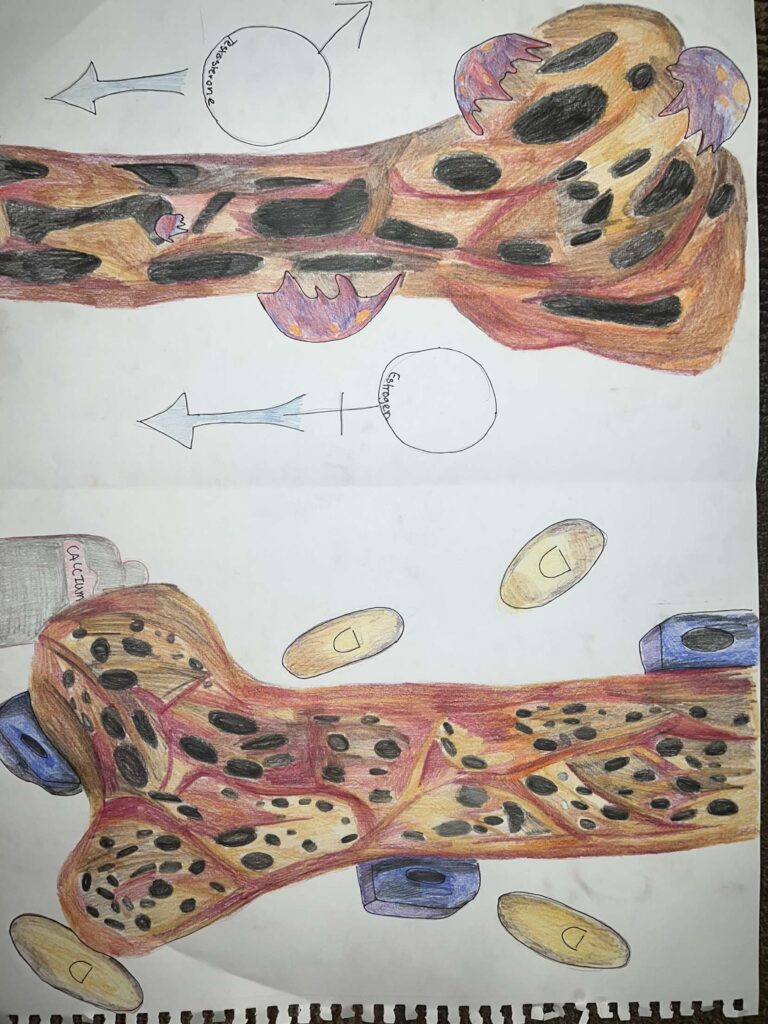My STEAM project explains the objective of how bone growth is hormonally regulated and how it relates to the occurrence of osteoporosis. Sex hormones and PTH regulate the activity of osteoblastic and osteoclastic cells (Almeida et al, 2016). Osteoblasts function to produce new bone tissue. Sex hormones and mechanical stress are what regulate osteoblastic activity. Parathyroid hormones stimulate osteoclast activity, which functions in bone resorption. Resorption is the process of bone tissue being broken down. The thyroid gland produces parathyroid hormone if the body has low levels of calcium. Too much osteoclastic activity or too little osteoblastic activity can lead to osteoporosis. Post-menopausal women are more susceptible to osteoporosis due to the lack of estrogen production.
I will discuss in this section how my media presents my objective of how bone growth is hormonally regulated. In my media I’ve depicted a pair of bones, one healthy and one osteoporotic. Alongside the bones are other representations of factors that encourage osteoblastic and osteoclastic activities. The factors include hormones such as sex hormones and PTH. I’ve drawn factors of healthy bone growth and resorption. I’ve depicted factors of healthy bone growth alongside the healthy bone. Factors which lead to osteoporosis are shown alongside a weakened and brittle bone. I’ve drawn it this way to represent the factors that determine healthy or unhealthy bone development. Factors which are shown to affect bone growth include stimulus ranging from hormones to diet and mechanical stress. Hormones which regulate bone growth and resorption include PTH and sex hormones. Weight bearing activities are a form of mechanical stress which causes bone growth. Diet talks about the intake of minerals and vitamins such as calcium and vitamin D that are needed in the body to limit osteoclastic activity. I’ve depicted these in my drawing to help show more understandable sources of these factors.
I will now discuss my research on the specifics of who is susceptible to osteoporosis and what they can do to avoid it. Several conditions and unhealthy lifestyle choices can cause young people to be more susceptible to osteoporosis. Overactive parathyroid glands, lack of mechanical stress, and unhealthy diet are all factors which contribute to the development of osteoporosis (National Institute on Aging, 1988.) Taking both calcium and vitamin D supplements ensures that the body has enough minerals and vitamins to support healthy bone growth (Sözen, Özışık, and Başaran, 2016.) Taking supplements alongside exercising and following a healthy diet can reduce the risk of developing osteoporosis. Post-menopausal women are more susceptible to developing osteoporosis. Post-menopausal women are more likely to develop osteoporosis due to the lack of estrogen production after menopause. Post-menopausal women should therefore take more preventative measures to avoid the development of osteoporosis (Sarafrazi et al, 2021.) To find out if the development of osteoporosis has started, taking a bone density test is advised (Mayo Clinic, n.d.). Chronic conditions that result in osteoporosis include overly active thyroid glands that release too much PTH or damaged reproductive glands (Sözen, Özışık, and Başaran, 2016.) It is advised to take preventative measures if any conditions that lead to osteoporosis are present (Mayo Clinic, n.d.)
References
Sözen, T., Özışık, L., & Başaran, N. Ç. (2017, March). An overview and management of osteoporosis. European journal of rheumatology.
Almeida, M., Laurent, M. R., Dubois, V., Claessens, F., O’Brien, C. A., Bouillon, R., Vanderschueren, D., & Manolagas, S. C. (2017, January). Estrogens and androgens in skeletal physiology and pathophysiology. Physiological reviews.
Centers for Disease Control and Prevention. (2021, March 31). Osteoporosis or Low Bone Mass in Older Adults: United States, 2017–2018. Centers for Disease Control and Prevention.
Mayo Foundation for Medical Education and Research. (2021, August 21). Osteoporosis. Mayo Clinic.
U.S. Department of Health and Human Services. (n.d.). Osteoporosis. National Institute on Aging.


Elliots STEAM project covers the objective of how bone growth is hormonally regulated and how it correlates to osteoporosis. His literature review explains osteoblastic and osteoclastic activities, and its regulation through sex hormones and parathyroid hormones (PTH). The imbalance – too little or too much – between the two cells can lead to osteoporosis with post-menopausal women being more prone to the disease because of the lack of estrogen production. His media subjects a healthy bone and another that is osteoporotic with other depictions of factors such as the sex hormones and PTH that stimulate osteoblastic and osteoclastic activities. The art also shows the growth of a healthy bone and resorption, as well as factors of healthy bone growth by healthy bones. The elements that contribute to osteoporosis are depicted as well as weakened and brittle bones in order to illustrate the determinants of healthy versus unhealthy bone development. Weight bearing activities are discussed as an avenue for mechanical stress causing bone growth. And, diet intake of minerals and vitamins including calcium and vitamin D are required for limitation of osteoclastic activity. Elliot discusses the type of people who are more prone to osteoporosis and what can be done to avoid susceptibility. Osteoporosis is more prominent in individuals who have overactive parathyroid glands, a lack of mechanical stress, unhealthy nutrition/diet, and post-menopausal women. Intake of calcium and vitamin D supplements can allow for the body to receive the nutrition and minerals it needs in order to support bone health and development.